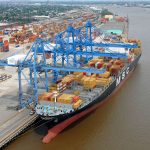The Arrival of Smart Ports Marks a New Era in Freight and Logistics
This is a guest post by Brad Smith.

Around the world, more advanced information and communication technology (ICT) and Internet of Things (IoT) systems are changing the way we live, do business, and organize our lives and processes.
Like many sectors and industries, import and export is also making the shift to intelligent, data-driven systems and models. Perhaps this is most apparent in ports, the very place where goods are handed over, loaded, and unloaded — and the place that is arguably most important to import and export companies.
We often hear that import/export and shipping and logistics as a whole is an industry that is resistant to change, stuck in the old way of doing things. But today’s smart ports would suggest otherwise.
What Are Smart Ports?
Smart ports are ports that utilize the very best that modern technology has to offer. By embracing IoT, newer ICT technology, artificial intelligence (AI), automation, and blockchain, among others, smart ports are capable of organizing systems and processes in a way traditional ports are not.
Part of a broader move toward smart cities, smart ports are responding to worldwide changes such as geopolitical conflicts, shifting alliances, the speed at which goods ship, and the size of our ships. To meet these new challenges, ports have to embrace digital maturity.
What smart cities are is data-driven hubs that rely upon masses of information to drive better choices and systems, and make processes simpler, cleaner, and easier. And smart ports are the same.
According to Joyce Bliek, the Port of Rotterdam’s Director of Digital Business Solutions, failing to adapt to newer technologies could mean a port is left behind. Bliek further explains how a dual approach that covers both physical and digital adaptations can make a big difference in real-life infrastructure.
For example, building a new quay wall or break wall without the smart analysis digital solutions offer could mean a much more expensive project. Testing a new structure’s functionality before it is built gives clearer insight into its impact on the port as a whole. This is perhaps best seen in the Port of Rotterdam’s “digital twin” model.
Additionally, any money that is saved through the increased digitization of systems is money that can be reinvested into stronger physical infrastructure, meaning a port can further improve its efficiency.
Smart Port Concerns
There’s no doubt that smart ports confer great benefits to the import/export industry, and to shipping and logistics as a whole, but there are some pressing concerns that need thorough consideration.
After Maersk was hit by a devastating cyberattack in 2017, it quickly became apparent that logistics needed to pay better attention to cybersecurity. One simple piece of code brought normally bustling ports to a standstill and crippled operations.
In smart ports, a greater reliance on digital solutions opens the door to a greater number of potential vulnerabilities. These must be addressed in a proactive fashion and digital systems have to be designed with an extraordinarily strong focus on security.
Port staff members who have any interaction with digital systems also need regular and comprehensive training on the cybersecurity risks that are present. Investing in cybersecurity to this level does carry a financial toll, but it’s one that must be accepted for smart ports to work safely and effectively.
This was a guest post by Brad Smith.

Writer’s Bio
Brad Smith is a technology expert at TurnOnVPN, a non-profit promoting a safe and free internet for all. He writes about his dream for a free internet and unravels the horror behind big techs.




